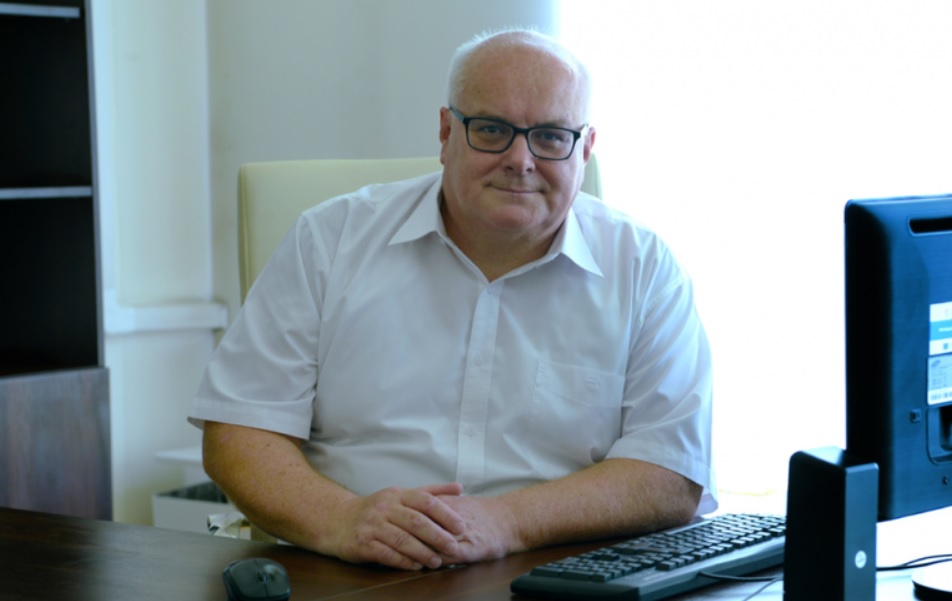The development of robotics is unbroken, even exponential. Robot technology will bring about such drastic changes in our everyday lives that we must prepare for it. Géza Husi, the dean and head of the department of the Faculty of Engineering of the University of Debrecen, outlined for us the technological possibilities and potential problems of the near future. During our interview, we talked about the transformation of engineering education and why it is worth choosing a technical specialization in Hungarian higher education these days.
How would you separate group work-based education from project-based and cooperative education?
I use the term group work to mean that there are at least two people who work together, because if the teaching is project-based, then each student is given a task, and then they are left alone to solve the project. Cooperative means that they can communicate with each other, but as an engineer, I interpret cooperation not as the cooperation of two people, but also between man and machine. Cooperative cooperation is possible by being given a task and in the process using today’s modern technologies – for example, a chatbot or other artificial intelligence. For this, we really need to transform our education, because we cannot teach students only simple lexical knowledge, but rather the transfer of deeper, more complex knowledge is necessary.
The kind of abstraction ability must be increased in the student so that they can put together their partner’s knowledge, their own and information from artificial intelligence into a meaningful result. It is no longer necessary to teach and assess, for example, whether the student knows the syntax and semantics of all commands on a programmable device.
At the moment, we are already at the point where the machine gives answers to the questions asked in Hungarian to the basically English-speaking chatbot in such good Hungarian that it is impossible to tell whether they were formulated by artificial intelligence or by humans. Artificial intelligence is already capable of stringing together very difficult sentences, and we must prepare for this. When I went to university, we still used slide-rule, but in order to be an instructor here, I did not have to teach slide-rule, since computers began to spread in the 80s, and later cloud-based databases and VR (virtual) engineering systems, not to mention about smartphones.
All of these have greatly changed engineering. Traditional engineering – very simplified of course – used to consist of having standards and designing a product, technology, process, etc. based on them. In the future, there will be a need for several kinds of engineering work, and there will be engineers who will be the best in that they will be able to best apply special technologies.
Will this group teaching result in fewer lectures?
It will be different. We prepare students to be able to cooperate well in groups. Because what are students currently being prepared for? It is forbidden to use assistive devices, it is forbidden to whisper and help each other. But why is this a problem? Isn’t it good if at least one out of two of them knows the solution? Why is it wrong for someone to take out their smartphone and get information from it to solve a problem? People’s ability to abstract is that they can decide whether the information they have obtained is relevant or even a possible answer to the question they have been given.
So the exams will not focus on subject knowledge, but rather on solving specific problems?
Yes, and not only the exams but also the semester assignments. These do not ask for lexical knowledge but will focus on the meaningful use of existing aids.
How popular is this new type of approach among educators?
At the end of the previous year, the Faculty of Engineering completed the implementation of its educational strategy for the previous 10-12 years. For this year, we planned to prepare a new strategy for the next 10-20 years. We thought about what the future would be like. We have to educate not (only) the present, but also the future, so that those who leave here (they are mainly MSc students) in the next 20 years – by the time they are 45 years old – will use the technology, procedures and machines used at that time they can create it. We need to go back to strengthening knowledge such as mathematics, which allows us to model and simulate. For example, a computer plays in a few minutes what might happen in 10 years according to what we know today. We can see what kind of responses we can get to certain changes in the future. An example of this is if a law suddenly prevents a product from being placed on the market, it is necessary to examine what will happen.
What are the needs of companies now?
They have two types of needs. One thing that is always the same at every moment is that the students who graduated here can manage and operate today’s technology. Today’s technology is not tomorrow’s and the day after tomorrow’s. We need to prepare for the future, and for this, as I mentioned, mathematics will be our greatest help. In Debrecen, for example, it is a big advantage that every established company has brought here its highest level technology, but this will no longer be the highest level tomorrow. It’s a big challenge because we can’t say what will happen in thirty years.
What exactly does Neurotech mean, and what kind of collaborations are emerging within this framework?
Everything that deals with some kind of information processing is part of it. It has physiological aspects, but it also has technical aspects. I believe that neuroscience plays a key role in addressing some social challenges. It certainly sounds interesting coming from the mouth of an engineer, but it must be seen that neuroscience may soon become an applied science, and engineers will also have the task of proposing solutions to technical, economic, environmental and even social problems in the coming decades based on neural functioning.
NeurotechEU aims to create an ecosystem to address this new challenge, which is definitely based on education, research and innovation.
Cognitive robots are a good example of this. Whereas today in a factory, the robot works like an animal in the zoo: it is fenced off, and while it is working there, no one can enter. On the other hand, a human can be present in the cognitive robot’s workspace, because the robot cell is structured in such a way that the robot always knows the position of the human and never harms people, otherwise, an industrial robot hits as hard as a world champion boxer. Our job here is to see how people can relate to robots. Many people think that a good robot is humanoid – this is not necessarily true. There is research on exactly what type of robots people like. And in order to be able to prove liking and to be able to examine and shape people’s stereotypes about robots, the help of psychology is essential.
Another example is dentistry. In pure medicine, the dentist works with their hands and heals with their hands, using a tool that they call a drill and what engineers call a burr. Technology is now at the point where a photo can be taken inside the mouth, the tooth can be designed, it can be manufactured, and the doctor has to implant it. This is also a classic collaboration between doctors and engineers. We are launching such a training course, which will help dentists with technical knowledge.
The car is also a very interesting human-machine interaction. The comfort experiences of those who drive the car and those present as passengers are completely different. It is necessary to create an environment with a completely different cost in a vehicle in which the passenger travels only thirty kilometers than in one that takes people, say, 300 kilometers.
How will this engineering education be transformed?
According to our current vision, there will be subjects, cross-subject projects,s or group tasks, in which the student must know all of the subjects in one semester in order to be able to solve the task. Therefore, mathematics, informatics, and a materials science subject, as well as a control theory subject, will run side by side, and the task will be such that it will be possible to complete the semester task with knowledge of all of these.
We would like to break down the walls between subjects so that if, for example, the student comes out of a math class and enters a material science class, the student does not forget what they heard in math class and is not offended that a simpler mathematical operation comes up in a material science class.
We have a goal of where we want to take the technical arm. This is a risk, but we take it. We cannot bypass the output requirements of the training, so it is not a question of abandoning something, but rather we want to introduce a different negotiation.
In connection with this, are changes expected in the buildings of the faculty?
There will be construction, as a result of which labs will be created that will not limit education to a single subject. We plan to create labs that perform multiple functions and can present the same problem from different perspectives.
We will advertise subjects in English for Hungarians. Our idea is that anyone who graduates from us must complete a subject in English. In this way, students also give an account of their professional language skills. Students coming from abroad, from a different culture, and socializing in a different way, increase the synergy of this. Today, companies also operate in such a way that employees solve tasks in groups.
Is it possible to summarize the faculty’s strengths, weaknesses, and opportunities in the manner of a SWOT analysis?
The main problem of the technical faculty stems from its past, that is, from the fact that until 2007 it operated like a college, and the requirements for instructors were also at the college level. Then, in 2007, we were able to start our first master’s program, and since then we have embarked on nine more, which can still be polished. It is also a problem that we have outgrown our buildings. At the time, it was planned for 80 students, and now we are at 3,000. Although we recently added a new wing, it is not enough now, so we are looking forward to the next investment, where we will be able to provide space for new technologies and knowledge. In addition, we need to improve our visibility in the world’s technical elite organizations, in the engineering community.
If we look at our strengths, it also stems from our past and our training is practical. All our former students say that they gained a lot from this. Tools used in industry and measuring exercises are available to our students. The proportion of the latter in all our majors is more than 50 percent. A major strength of the faculty is the significant number of foreign students. We have several departments that work for companies, so we have direct insight into the companies’ plans. Another strength of the faculty is that 80 percent of the instructors and 90 percent of the engineering instructors have worked somewhere before, so they also bring real professional experience with them. Our 14 company-supported labs and 10 outsourced departments are definitely a strength.
Our opportunity is that one of the areas taught at the Faculty of Engineering stands out and pulls the entire faculty along. Mechatronics is the most likely to do this, but it is also possible in the field of architecture.
Who are the faculty’s main competitors? Miskolc, the Budapest University of Technology and Economics, maybe Timisoara and Kassa?
The country is so small that practically everyone is. If we look at the number of students, we are already ahead of many universities. According to last year’s statistics, there are a total of 64 universities in Hungary, and if the Faculty of Engineering of the University of Debrecen were an independent university, it would be in 20th place on this list.
Will the staff increase last longer?
Rather, restructuring is expected. Currently, we have no students from only two Hungarian counties, and the number of foreign countries from which students have come to us is over 100. 10 percent of our students are Hungarians from across the border. Thus, too much expansion is no longer possible.
What proportion of your students stays here in the region after they graduate?
In Hungary, it is typical that 80 percent of graduates are located either near their university or where they live. Since the job opportunities in Debrecen are very good, there are good job offers, and a lot of students stay here. This was not the case 10 years ago, the best students left the city and never came back. Today, however, many people stay here. Many companies can also be assigned to our training. For example, Vitesco supports our electrical engineering training, and NI – National Instruments supports the learning of mechatronic engineers in addition to electrical engineers. Our civil engineering training is also supported by companies, and we are also in negotiations with BMW. We also maintain good relations with companies in Budapest.
Why is it worth teaching, learning and working at the Faculty of Engineering?
I would like to return to the previously mentioned strength of the faculty: we maintain very close relations with companies. So we know exactly what these companies will do in the near future, and we have insider information about what developments they are planning. The technical career can be a very good choice because the industry in Debrecen uses the technologies and knowledge taught by us and needs them. We discuss this with the companies twice a year. It is worth studying here because you can get out of the training in a structured way. You can graduate with a BSc degree, knowing today’s technology, you can graduate with an MSc with the necessary knowledge to create the technology of the future, and according to our new ideas, you can even become a scientist-engineer.
Many jobs will be taken over by artificial intelligence, especially in administrative jobs. What skills will the workers here need to acquire?
That they can work together with artificial intelligence. For example, the meter reading will cease, since the electricity, water and gas meter will send the data by itself. In a few years, bills will be prepared automatically based on the data provided by smart meters. The administrator is connected when the payment is missed or the invoice is not received.
Could Spielberg’s A.I., as an artificial intelligence capable of emotions, be realized in the near future?
Not in the form shown in the movie. At the same time, sooner or later the so-called social robots will become available. People will learn to live with the robots that help them in their lives. Those who need little help will not have a robot for a long time, but those who are limited in anything will. For example, why can’t robots change the wheels of cars?
In science fiction, even wars are fought by robots…
In principle, the robot will always know as much as a human, but if the robot works in a group and takes advantage of its synergy, it can know more than we do. And this means that you will be able to make much better strategic decisions than a human. I really want this ability not to be fulfilled in wars. I dare to hope that the engineers will think soberly, and not use the technology to start a war. To give an example, a good locksmith can open any lock, but the robot will not become a thief.
In connection with distance learning, you stated that it has dowries and these must be kept. What are these?
For example, not all classes have to be held in person. For example, I have a course that is about modeling a process. It’s much easier for me to keep it so that they can see my screen over the internet, they can see what I’m doing, and the students can ask me about things.
There were, of course, negatives to the forced distance education due to Covid, perhaps the most sensitively affected by this was pilot training. After all, if you can’t fly, the student can’t pass the exam. Apart from a few exceptional situations, the final exams were always held in attendance.
In recent years, the team has participated in various competitions with several alternative-drive cars. Where have these vehicles gone now?
The answer to this is very simple: they do not hold such competitions. The Széchenyi Race has ended, the Pneumobil competition has also been canceled, and Bosch no longer calls out tenders for car construction. That is why we are going in a new direction, which is an international competition called Formula Student 1. If all goes well, this year there will be a racing car from Debrecen.
Do you see a chance of realizing a flying car in the near future?
There would be a chance if they could comply with aviation safety rules. As a prototype, it is very easy to implement such a thing in closed conditions, but their use in traffic is currently unthinkable. Currently, it is not viable for someone to own a flying vehicle because it costs a lot to maintain. If you go with it every day, then it has a right to exist, but this is not typical for the majority.
– Sándor N. Nagy –


















